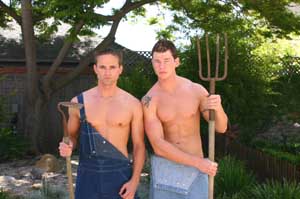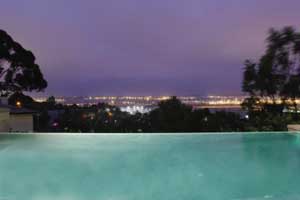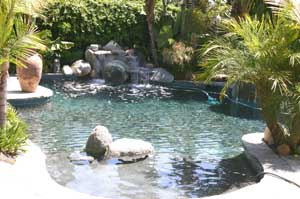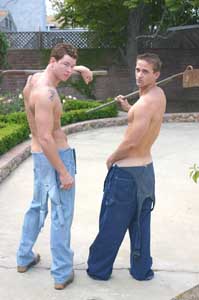feature
The gay outdoors
Published Thursday, 14-Apr-2005 in issue 903
San Diegans have even more reason than most to reclaim, emphasize and make over our yards, patios and balconies. We live in one of the most expensive housing markets in the nation, where homes average over $300 per square foot – higher downtown and in neighborhoods like Hillcrest, University Heights and North Park. Luckily, we also live in a city where the weather permits us to use our outdoor spaces year-round, even when the winter is a bit colder and wetter than usual. It’s no wonder, then, that San Diegans take so much pride in their gardens, plantings and fountains.
We live here for the weather
No matter where people live, they take pride in their lawns, yards and gardens, but for much of the country, the opportunities to use that space is limited to the warmer months. If there’s one thing that’s exceptional about San Diego’s climate, it’s that we can enjoy the outdoors throughout most of the year.
It’s this opportunity to use the outdoors – to make it functional – as well as San Diegans appreciation of it, that Andrew Vesey of Vesey Landscape Design sees as the biggest distinction between his native Washington State and Southern California.
“Here in San Diego, people live outside much more than they do in the Northwest,” he says. “People live outside everywhere, but here, in designing the landscape, you definitely have to take into account that people are going to be living outside.”
At the same time, the idyllic weather can lead people not to appreciate just how good we have it in San Diego.
“In the Northwest, people will take the day off if it’s sunny, because they appreciate it,” Vesey adds. “Here, sometimes we just take it for granted, because it’s always nice weather. And even though the weather is so good all year long, we get acclimatized. Still, when you are designing for other parts of the country, the design of a yard is more aesthetic rather than functional. Here, it’s very much both aesthetic and functional.”
“People in San Diego and Southern California live in their gardens more than people do on the East Coast,” agrees Matthew Doerr of Matthew Doerr Landscape Design. “In San Diego the garden is much more of an extension of their home.”
Doerr has carried this sentiment through with the building of his own new home, replacing the one that burned last year.
“Even when I’m building my own home, I’ve included a big, huge courtyard as living space,” he says.
The way in which outdoor and indoor living spaces blend together has also been a factor in the designs David Horst of Horst Design and Keith Roberti of KR Interiors have provided for a Mission Hills home with a view of the city and the bay. In the initial design several years ago, Horst included a vanishing-edge pool and spa, making the pool seem to float above the valley below and taking advantage of the view and the openness of the home itself, which opens onto the backyard with walls of glass.
“I’d say that the background or the view determines what should be done in the area before it. The unobstructed view of the water called for a vanishing edge-pool,” Horst says. “If we’d have built a standard pool instead, the drama of the view would’ve been lost. The reason I specified the 20-foot sliding-door unit from the great room onto the patio was to bring the outdoors inside and to help create one huge living area. The beautiful climate here is a huge asset to outdoor living.” In emphasizing not only the blending of inside and outside but also the visual blending of the water of the pool with the water of the bay, Horst adds, “I’d be a shame to let these areas go to waste.”
Because this house was recently sold, Horst and Roberti are redesigning the outside to showcase even more starkly the outdoor living possibilities.
“As for the future of the house, we’re building an outdoor kitchen, fireplace and shower on the view side of the property,” Horst says. “On the hillside below the pool, we’re going to cantilever a game room/guest room. On the street side, we’re building a short wall and an entry courtyard to provide a more intimate front entrance.”
This connection between indoor and outdoor living space also helps explain Doerr’s path to landscape design. Although he started out as an interior design student in Philadelphia, he didn’t finish that program but instead opened an art gallery. When that was less than a financial success, he ended up managing and renovating apartments, gaining an appreciation for the ability to start something from scratch and see a vision completed.
Finally, he ended up in California working for a friend who owned a nursery specializing in plants native to Hawaii.
“A woman came in wanting palm trees for inside her house,” Doerr recalls. “We told her that we didn’t do that, but I ended up helping her with inside landscaping. And, one month later, I had six clients doing interior designing with plants.”
Doerr made his move outside, shaping and pruning hedges to better frame and showcase the doorway of a client’s home. His first landscaping client was a big project on which he learned just how involved landscaping could become.
“It was a Home Owners Association redesign. The whole property was 64 acres, but the HOA’s area was only three acres. I was ill-prepared for that job. I knew a little bit about lots of things,” Doerr recounts.
That first experience was followed by 12 years of working primarily on outdoor landscaping projects before Doerr started his own design company three years ago, applying both his interior design experience and his years maintaining his own and other landscapes.
“I’ve been landscaping since I was 5 years old. My mother had me pulling weeds. It’s in my blood,” he says, explaining that he’s really returned to his roots.
Vesey’s path to designing landscapes was more direct. He studied landscape architecture at Washington State University. A few years after finishing school, he moved to San Diego wanting to get away from his native Washington but still remain on the West Coast. He also figured that it would be better to start his career where the work is year-round.
“Landscaping is year-round in Southern California; it’s seasonal in Washington,” he explains. “There you spend the winter designing projects and the summer installing them, because you can’t start plants in frozen ground.
“I wanted to do this on my own,” he says. So, when friends of his asked him to do the design for their yard, he took the challenge. He quickly found, however, that even with his training, designing landscapes for the Southern California environment was not as obvious as it might have seemed.
“The palette [of plants] is entirely different in San Diego than it was in Washington,” Vesey says. “Plants that grow into trees outside here are houseplants in Washington. And there’s just no irrigating for plants there – for lawns, yes – but not for plants. We have every climatic zone in Washington, but here we live in a semi-arid desert, so irrigation is so important here.”
What Vesey describes as his own initial “befuddlement” with the plants growing in San Diego led him to the realization that he needed to get a lot more experience and knowledge of what will grow in Southern California and what needs to be done to make it grow here. So, he got a job where you get paid to spend a lot of time taking care of and nurturing plants – in a local nursery.
A paradise of plants
His year at the nursery taught Vesey a deep appreciation for a variety of native plants, many of which are underused and not as appreciated as they should be, he says. “There are so many native plants that people just don’t use as often as they should. People think of them as weeds. They see them growing along the side of the road, so they assume they must be weeds, but any plant is a weed if you don’t want it [to grow].”
Among the native plants that he likes and would like to see more use of is the ceanothus (California lilac). This plant tolerates the droughts that afflict San Diego most years and has beautiful purple flowers when blooming.
“Ceanothus is great for hillsides; for years like this when we have heavy rains,” Vesey says. “Ice plant [mesembryanthenum] is the worst plant for hillsides, and it’s what everyone uses. All the plant material [in ice plant] is on the surface, so it doesn’t do anything to stabilize the hill or stop erosion.”
Among other native plants Vesey recommends are the many native grasses that grow in Southern California, including the Santa Barbara daisy, manzanitas (relatively common native flowering shrubs) and meleleucas (a family of plants including myrtles, and the source of tea tree oil).
The great advantage to these plants, according to Vesey, besides the fact that they are already located in San Diego, is that they tolerate the relative lack of rain and the difficult soil of the region. Since they are from here, they just do better here.
“So much of what people choose to grow and think of as natural parts of the landscape just isn’t. There are no native palms here; they are a completely manipulated part of the landscape. That’s not necessarily a bad thing, though. It just shows that you can grow so many things here,” Vesey says.
“Lawn is the absolute worst thing for the environment in San Diego,” he adds. “It’s a monoculture, it takes so much water in a dry environment, it takes time and it requires lots of chemicals to keep it healthy here. It’s just not right for San Diego when there are so many other alternatives. But people have a mental connection to having a lawn. Sometimes, of course, it’s functional when you have kids or pets.”
Living in a desert (almost)
Even though the last few months of heavy rainfall make it easy to forget, San Diegans live in a dry environment. In an average year, we get less than 10 inches of rain. One thing this means for homeowners and landscapers is that water and irrigation is much more important in San Diego than in most places in the nation.
This isn’t made easier by the quality of either the water or soil we have. As most people know, Southern California gets the majority of its water from the Colorado. But to get that water here, it has to travel through concrete aqueducts. As Vesey points out, traveling through concrete causes the water to leech chemicals and salts from the concrete by the time it arrives. When added to what he calls the poorly draining, horrible clay soil in San Diego, this can lead to serious problems for plants.
“So many people water wrong,” he says. “Here, because of the water and soil, you have to water plants long and deep, meaning you have to water a half-hour at a time once a week, not a shorter period every day. Of course, things are different when you are establishing new plants, but that’s the guide once they are established.”
There’s another factor in San Diego weather that can sometimes be overlooked. Although we enjoy temperate weather throughout the year, we do have real seasonal variations in rainfall and sunshine. These variations make a difference in the way that a garden appears in the summer and the winter.
“Even if the weather is good for being outside, if you want your garden to look good in the winter, you have to plan for the winter,” Doerr says. “Most of what people plant even in San Diego doesn’t look so good in the winter. That’s why we use Bird of Paradise, because it is appealing even in winter.”
Planning your project
Along with the challenges posed by rainfall and soil, the weather in San Diego that invites so much outside living also opens amazing possibilities in plant choices.
San Diego has a Mediterranean climate. This means that plants that thrive in the Mediterranean, in southern Spain and France, Italy and North Africa, are likely to find just the right temperature and rainfall conditions in San Diego to thrive. Thus, the non-native palm trees have become almost emblematic of this part of the country. They do so well here because we have the weather of their native region.
Even though San Diego isn’t really tropical, its warmth and sunlight throughout the year means that it is situated in one of the few parts of the continental U.S. where tropical plants can thrive outdoors, given enough watering. That’s exactly why rubber trees and other kinds of ficus and Schefflera (umbrella trees) can survive in San Diego, while they are almost always used as houseplants in the rest of the U.S. It was seeing a Schefflera growing outside that first helped Vesey realize just how different the plants in San Diego are.
And, of course, Southern California is home to many, many eucalyptus trees. Far from their native Australia, these trees also thrive here. Like the palms, they are so ubiquitous that we often don’t think of them except when one falls or damages property, often because of inappropriate pruning.
Over-pruning and pruning trees in the wrong way is one of Doerr’s pet peeves. “It’s a crime when they trim the top off a eucalyptus tree. That’s one reason why, for cutting trees, you really need an arborist,” he says.
What all this means is that there are landscaping options in San Diego that you just don’t have in many other places. You can plant pines, maples, oaks, palm trees and cacti all in the same yard, with grass and succulents as groundcover, not that you necessarily would or should.
“San Diego offers the opportunity for many different plant palettes that can go with a person’s personality and the house they live in,” Vesey says. “You can go tropical, especially with a Craftsman-style house, or Mediterranean with a Spanish house, there’s an Asian palette or you can go Southwestern with plants like bougainvillea.”
But so many choices open up the chance that you may go wrong. That’s where the help of a professional landscape designer can really come in handy.
Doerr puts it this way: “I’m very opinionated. If I don’t think something is appropriate, then I’ll tell the client. Sometimes it’s ironic. I had one client who ripped all their landscaping out and then called me. I said this should go here, that should go there. They told me that that’s almost the same as what they had just ripped out. They should have called me first.
“They pay for my advice,” he adds, “but that doesn’t mean that a landscape designer just provides his own vision of what a garden or yard should be.”
This mix of the designer’s vision with the needs and wants of the client is also something that Vesey sees as essential to his work. For instance, if a client has their heart set on a big, grassy lawn, “I would try to steer them away from that, try to show them other possibilities and options. A designer is there to glean from the client what they want and what they think they want to help them appreciate other aesthetics and give them options. They can’t possibly know everything about plants; that’s what I’m there to help them with.”
He also has a vision for what an ideal landscape should include. It’s a vision matched by his own home, where the backyard is a virtual outdoor living room with a large, comfortable seating and living area surrounded by lush plant life, animals of the domestic variety and water.
“It should include all the elements of the earth: stone, plant life, water, lighting,” Vesey says. “There should be a fountain or even still water. The sound of water has such a calming effect, and water helps to attract the surprisingly abundant wildlife of San Diego.”
Vesey’s own home also exemplifies another of his design ideals. “It should be about movement between spaces, about identifying through landscaping, which are public and private spaces,” he says. “And a good design should create a sense of mystery, where a glimpse from a distance of, for instance, a door doesn’t tell you everything.”
Both Vesey and Doerr emphasize that a landscape designer is there to hold the hand of the client as the project is installed and grows in, when they become worried that a plant isn’t doing well or doesn’t yet look like what they had hoped it would.
With so many opportunities and options available to San Diegans, with our beautiful weather, and even when winters are as wet as this last one has been, the outdoors is calling us to make it a part of our living space. Even if it’s just to create a planted area on a balcony, to add to the plantings we already have, or if we have a huge garden to put our stamp on, spring is the ideal time to make the outdoors our own.
|
|
Copyright © 2003-2025 Uptown Publications





